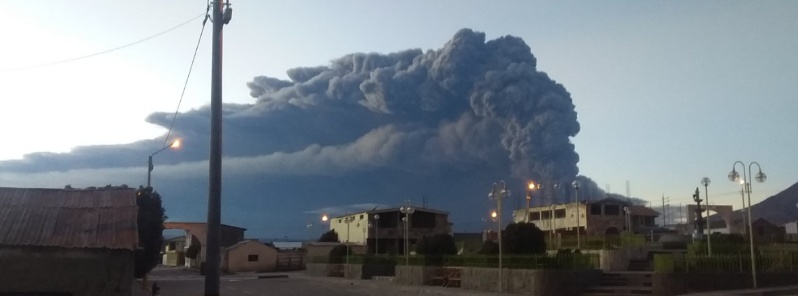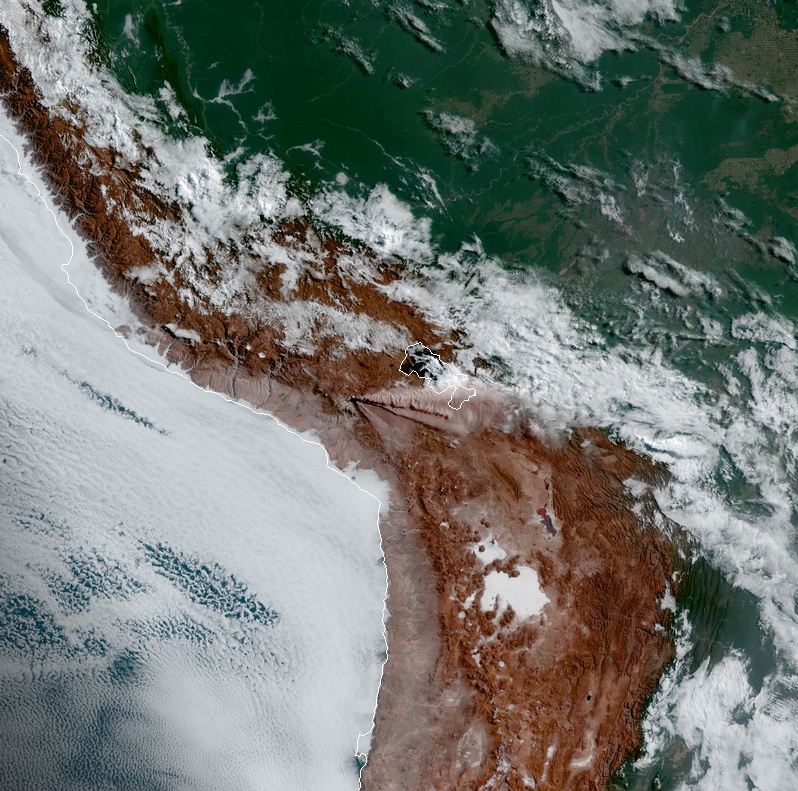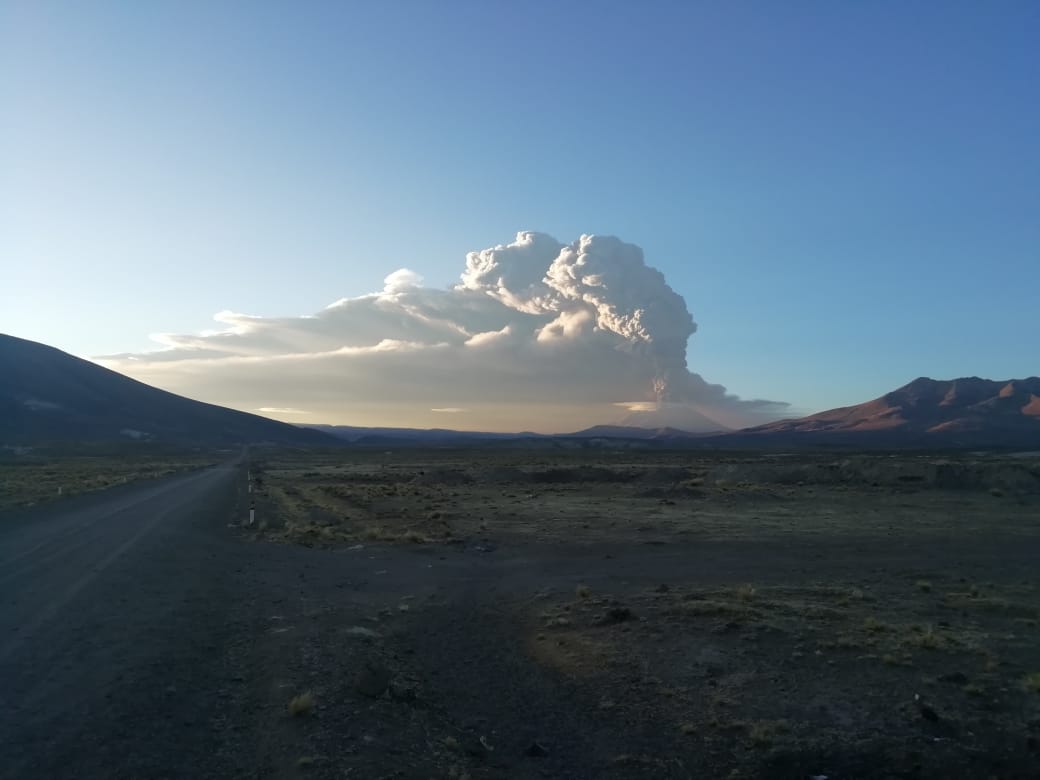Violent explosive activity at Ubinas volcano, ash to 12.1 km (40 000 feet) a.s.l., Peru

Violent explosive volcanic activity started at Peru's Ubinas volcano around 07:35 UTC (02:35 local time) on July 19, 2019. The Geophysical Institute of Peru (IGP) recommended raising the alert level from Yellow to Orange.
New information provided by webcam and satellite imagery obtained at 11:00 UTC showed that eruptive cloud is reaching a height of 12.1 km (40 000 feet) above sea level.
Ashfall was reported in the villages across Ubinas Valley and the Arequipa region – in the towns of Ubinas, Escacha, Anascapa, Matalaque, San Miguel, Huarina and Tonohaya for which an ash dispersion alert has also been issued so that the authorities and the population take measures to avoid damage to health.

Ash rising above Ubinas volcano at 12:50 UTC on July 19, 2019. Credit: NOAA/GOES-East, TW

Volcanic ash rising above Ubinas volcano on July 19, 2019. Image credit: IGP
The intense explosive activity recorded today has been repeatedly warned by the IGP during its latest technical reports, which detailed the record of earthquakes linked to the rise of magmatic material and the possible occurrence of explosions of greater intensity.
Volcano-tectonic events averaged 279 while long-period events (indicating fluid movement) averaged 116 events per day since July 1, accompanied by minor bluish emissions from the crater
The National Vulcanological Center (CENVUL), the country's service managed by the IGP for the monitoring and emission of volcanic alerts, has been carrying out the permanent analysis of the activity from the city of Arequipa, using the monitoring network installed on the volcano composed of 6 seismic stations, 2 scientific cameras, as well as GPS stations and inclinometers to determine possible deformations.
La naturaleza a veces nos vuelve a mostrar cuán grande es. #Ubinas pic.twitter.com/xxpsgXZFWW
— AnaLucia Vizcardo (@analucia_vm) July 19, 2019
#UBINAS: La ceniza puede afectar la salud de la población. Recomendamos: a) Protegerse los ojos utilizando lentes y usar mascarillas para proteger las vías respiratorias. b) Que las autoridades e instituciones competentes realicen una evaluación del impacto de las cenizas (2)
— Instituto Geofísico del Perú (@igp_peru) July 19, 2019
#UBINAS: imágenes de la actividad del volcán : la primera muestra el registro sísmico y la actividad de tipo tremor que estaría vinculada a la emisión continua de cenizas; la segunda, la expulsión de ceniza y proyectiles balísticos como resultado de las violentas explosiones. pic.twitter.com/QYSuayUWJV
— Instituto Geofísico del Perú (@igp_peru) July 19, 2019
Nuestras cámaras científicas en tiempo real viene tomando imágenes del volcán Ubinas cada 30 segundos. Observa a continuación las explosiones ocurridas desde las madrugada de hoy.
Recuerda que puedas verlas en tiempo real desde la app Volcanes Perú y la web del CENVUL. pic.twitter.com/OZ5Se5Qr5O
— Instituto Geofísico del Perú (@igp_peru) July 19, 2019
Desde las 2:30 a.m. de hoy, el #IGP viene alertando de la situación a las autoridades regionales a fin de que tomen acciones preventivas a favor de la población. (2/2) pic.twitter.com/BiHQ7QzKOz
— Instituto Geofísico del Perú (@igp_peru) July 19, 2019
[AHORA] Señales sísmicas que estaban siendo correlacionadas con emisiones de ceniza están regresando a niveles observados antes de las explosiones. Ello también queda graficado en la disminución de la altura de las explosiones, las cuales alcanzan los 1500 sobre el cráter. pic.twitter.com/uO7ST9EtnM
— Instituto Geofísico del Perú (@igp_peru) July 19, 2019
Geological summary
A small, 1.4-km-wide (0.8 miles) caldera cuts the top of Ubinas, Peru's most active volcano, giving it a truncated appearance. It is the northernmost of three young volcanoes located along a regional structural lineament about 50 km (31 miles) behind the main volcanic front of Perú.
The growth and destruction of Ubinas I was followed by the construction of Ubinas II beginning in the mid-Pleistocene. The upper slopes of the andesitic-to-rhyolitic Ubinas II stratovolcano are composed primarily of andesitic and trachyandesitic lava flows and steepen to nearly 45 degrees. The steep-walled, 150-m-deep (492 feet) summit caldera contains an ash cone with a 500-m-wide (1 640 feet) funnel-shaped vent that is 200 m (656 feet) deep.
Debris-avalanche deposits from the collapse of the SE flank about 3 700 years ago extend 10 km (6.2 miles) from the volcano. Widespread plinian pumice-fall deposits include one of Holocene age about 1 000 years ago. Holocene lava flows are visible on the flanks, but historical activity, documented since the 16th century, has consisted of intermittent minor-to-moderate explosive eruptions. (GVP)
Featured image: Eruption at Ubinas volcano on July 19, 2019. Credit: IGP

Commenting rules and guidelines
We value the thoughts and opinions of our readers and welcome healthy discussions on our website. In order to maintain a respectful and positive community, we ask that all commenters follow these rules.